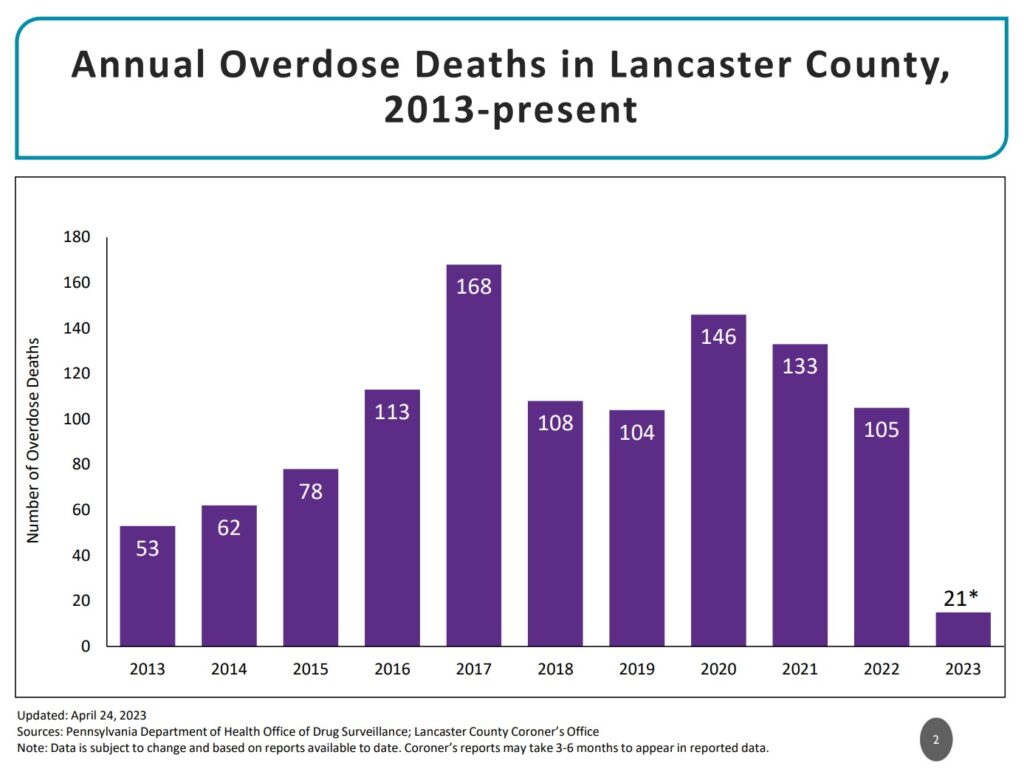“You should be proud,” county Commissioner Josh Parsons told the members of the Lancaster County Joining Forces coalition Thursday morning.

“There are people who are alive today in this community because of the work that you all have done,” he said. “… This has been a model across the commonwealth.”
Co-chaired by Parsons and Alice Yoder, executive director of community medicine at Penn Medicine Lancaster General Health, Joining Forces has worked since 2018 to bring together county agencies, nonprofits and health systems to combat the opioid epidemic. The organization’s spring forum doubled as a celebration of its fifth anniversary.
Joining Forces follows the federal Substance Abuse & Mental Health Service Administration’s guidance, Yoder said, with comprehensive evidence-based initiatives targeting prevention, treatment and recovery.
Asked to name Joining Forces’ main achievements, Parsons cited the county’s significant reduction in opioid overdose deaths. In the coalition’s first year, overdose mortality dropped 36%, from 168 to 108. Deaths spiked in 2020, the first year of the pandemic, as they did nationwide, but dropped in 2021 and 2022, even as national rates kept rising. So far in 2023, there have been 21 overdose deaths countywide.
Annual overdose deaths for Lancaster County, left, and the U.S. right. Click each chart to enlarge. (Sources: Joining Forces | National Institutes of Health)
Fentanyl is responsible for the vast majority of overdose deaths here, said Brenda Buescher, health promotion specialist at LG Health, who presented coalition’s latest roundup of statistics to the forum.
The death rates for Blacks and Latinos and other races are higher than for Whites, and while the death rate for Blacks has fallen, the rate for Latinos has risen. The caveat is that the numbers for non-White populations are smaller, which makes it more difficult to distinguish between robust trends and random variation. About 5.5% of Lancaster County’s population is Black and 11.5% is Latino. Among the 105 overdose deaths in 2022, fewer than 10 victims were Black and fewer than 25 were Latino.
Toward the end of the forum, participants were asked to brainstorm ways to be more effective at preventing deaths in non-White populations. Among their suggestions: Involve representatives from those communities in planning and strategizing, diversify the social service and treatment workforce, increase outreach and collaborate with grassroots community organizations.
About twice as many men as women die of overdoses in Lancaster County. While that may not seem particularly surprising, the ratio differs widely across jurisdictions, Buscher said. In three states, female death rates exceed male ones.

‘We work as a community’
A series of presenters who followed Buescher gave rapid-fire summaries of their organizations’ work: educational campaigns, naloxone distribution, expansion of medication assisted treatment and efforts to reduce stigma and help individuals in recovery reintegrate into the community and live healthy, productive lives.
“We work as a community,” said Mitch Crawford, director of addiction services at WellSpan Philhaven. He celebrated the U.S. Drug Enforcement Agency’s apparent decision, in response to a backlash from the treatment community, to delay reimposing tight restrictions on prescribing controlled substances via telephone for substance abuse disorder.

District Attorney Heather Adams said she’s very pleased with the results so far of Pathways to Recovery, the diversion program her office launched at district judges’ offices last summer. It allows eligible individuals charged with low-level offences to enter a recovery program and have their charges waived upon successful completion.
“I think it’s taking off,” Adams said.
Unlike its predecessor program, which was remote and had no local staffing, Pathways to Recovery clients receive intensive in-person support through two local nonprofits, Second Chance PA and Compass Mark. With more than 100 cases to date, the number of enrollees who have failed drug tests or dropped out is below 20%, versus a roughly 50%-50% success-failure rate previously.
Rick Kastner, head of the Lancaster County Drug & Alcohol Commission, listed the new or expanded services supported by his office over the past five years: Renovations and expansions at recovery houses and rehabilitation centers, the launch of a mental health / substance abuse disorder outpatient clinic in Columbia and a new men’s halfway house, as well as the expansion of the Student Assistance Program, a school-based assessment and referral program.

He warned of the potential effect of the resumption of Medicaid reenrollment. Estimates suggest that up to 20% of the 118,000 Lancaster County residents on Medicaid could lose coverage, and since Medicaid pays for addiction treatment, “that could become very problematic,” he said. (State officials say they will make every effort to enroll individuals who lose Medicaid in other coverage programs, but advocates worry that many people could still end up falling through the cracks.)
At the end, the audience was polled on Joining Forces’ future direction: Should it maintain its narrow focus on reducing opioid deaths, or broaden its approach? A large majority voted for broadening, to “reduce the harmful impact of substance use” generally, including addressing associated heath issues and trauma to family members.
County Commissioner Ray D’Agostino said he was encouraged by the forum and the cooperation it represents.
“No one sector, no one group, can do it all on its own,” he said.
Decisions pending on use of additional opioid settlement funds
Last year, a Joining Forces work group helped Lancaster County develop a framework (PDF) for spending about $16 million it will be receiving over the next 18 years from a set of nationwide opioid lawsuit settlements.
It calls for funding five priorities: Neonatal abstinence support, the Student Assistance assessment and referral program, the Pathways to Recovery diversion program, the Drug Task Force and Medication Assisted Treatment at the County Prison.
This spring, the county learned it could be receiving to $12.9 million from additional settlements. That prompted some discussion in March about whether the framework should be revisited in connection with the additional funds.
On Thursday, Commissioners Josh Parsons and Ray D’Agostino both said that will happen, but not for a while.
Parsons said the county is hewing to its framework for the first tranche of settlement funds and that he expects discussion of the additional money “in the next several months.”
One issue: The county doesn’t yet know how much it will receive, because the settlement amount depends on how many jurisdictions participate. Once that information becomes available, that will trigger the discussion, D’Agostino said.









